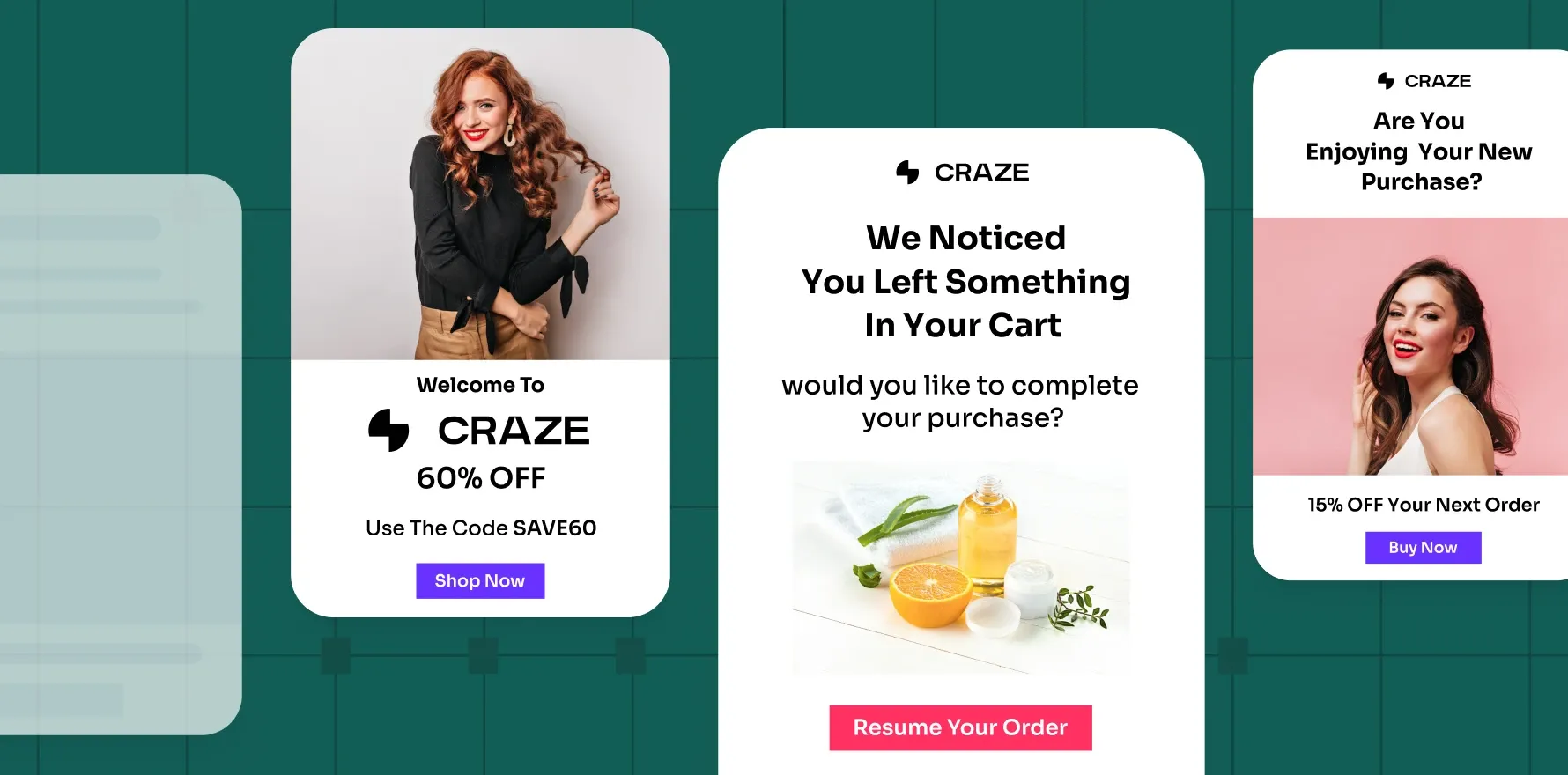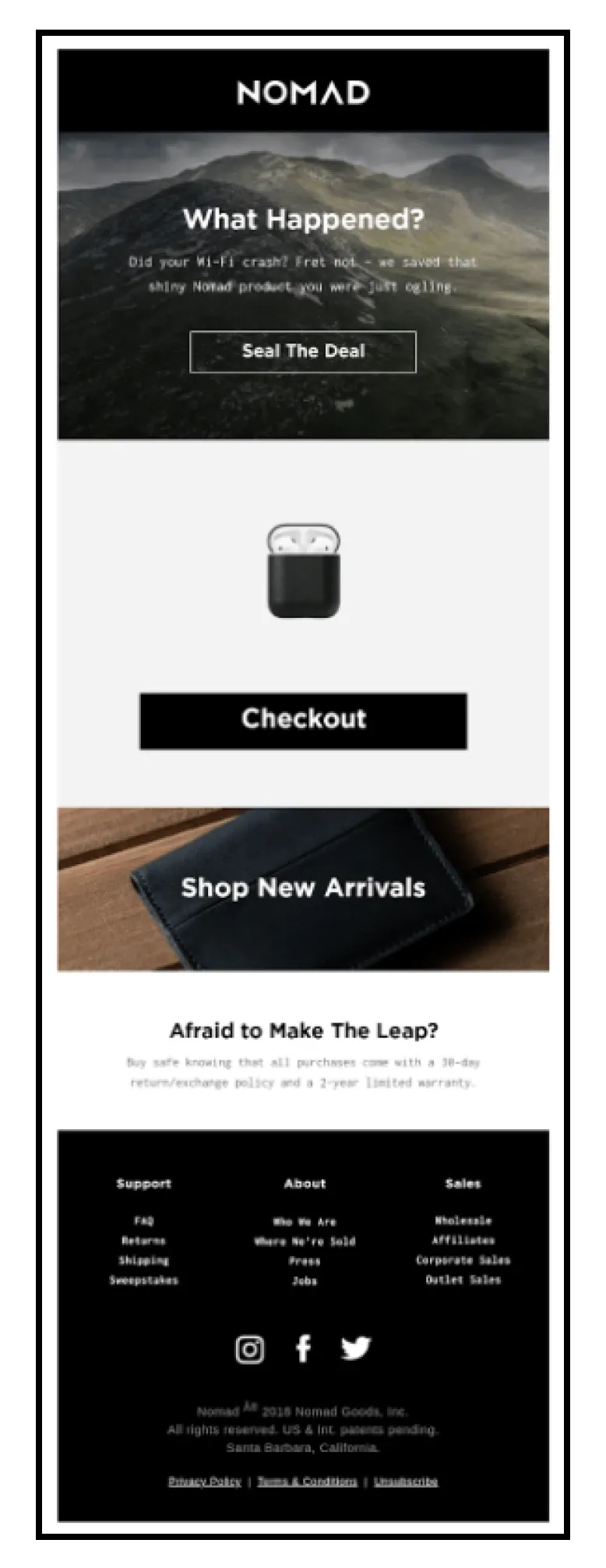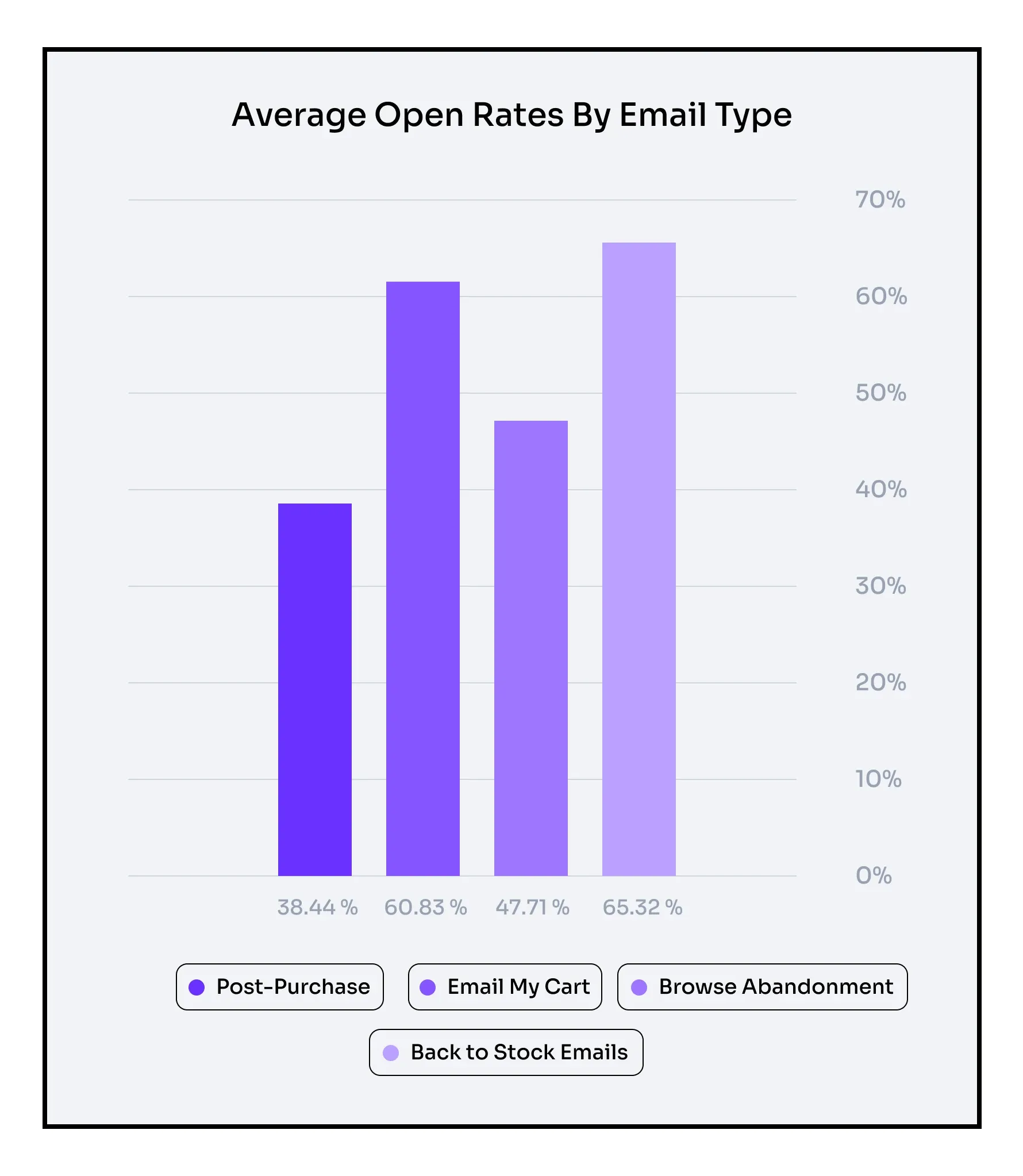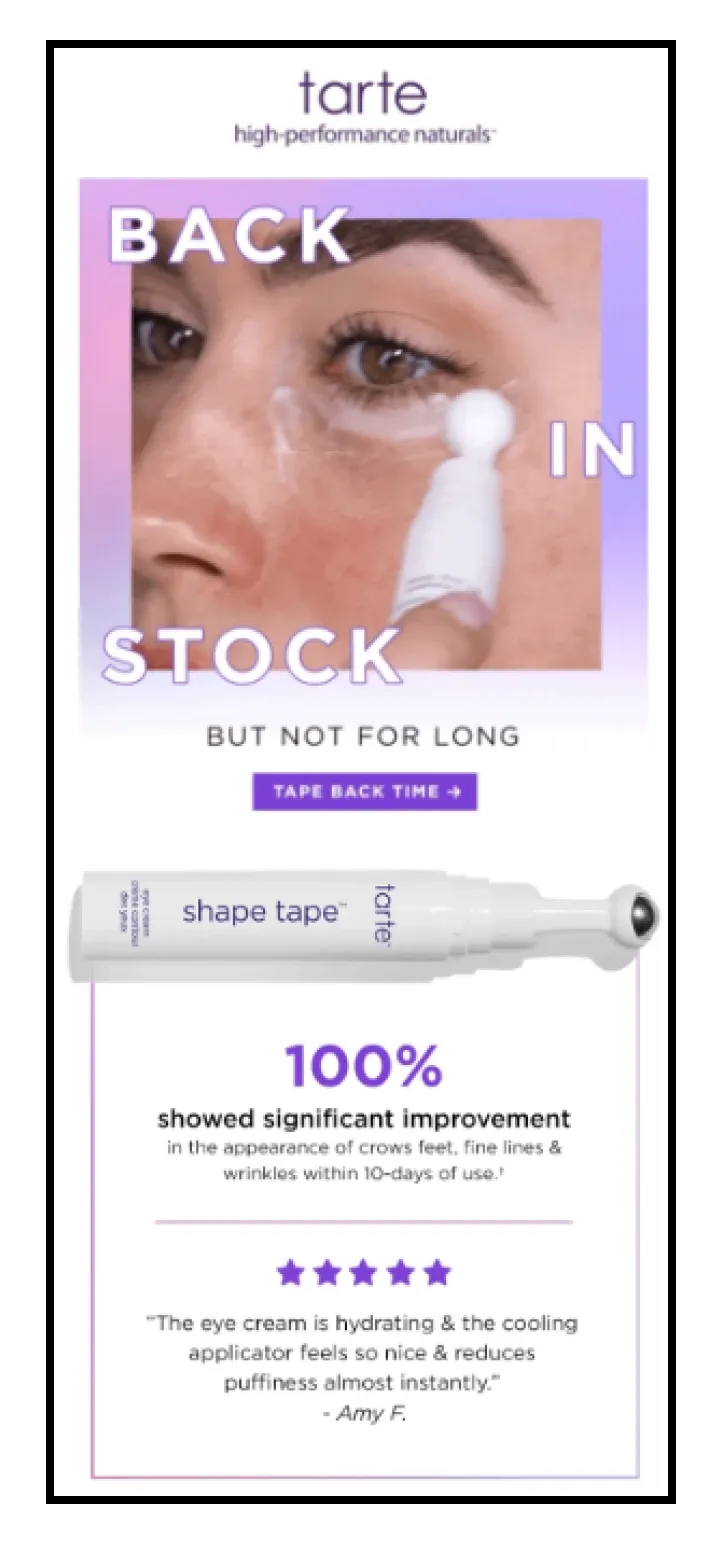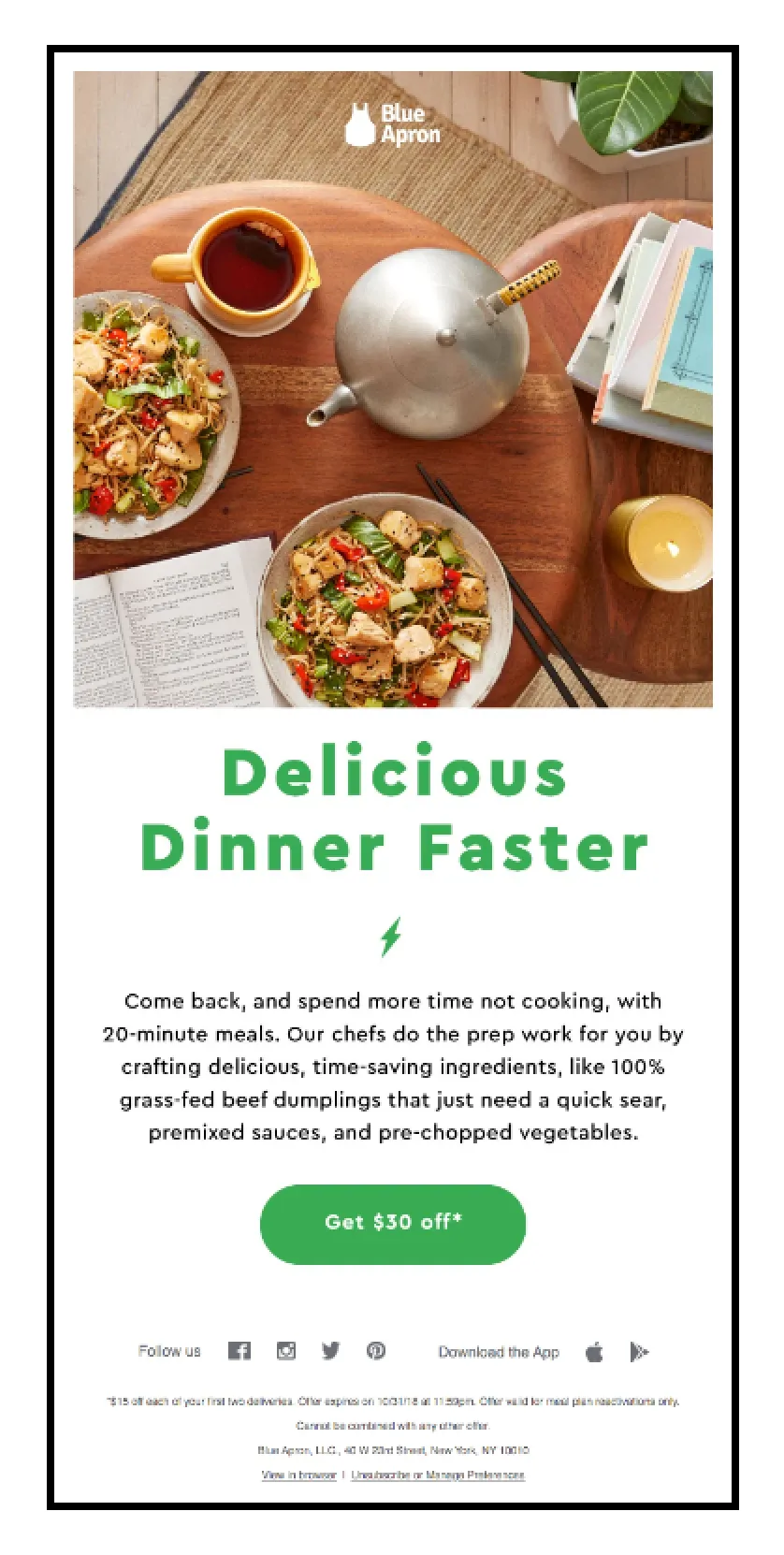What if we told you that there were five automated emails you could send that would significantly boost your revenue? You can use these five emails as the foundation for your entire email marketing strategy.
Obviously, you don’t want to send a random email to your audience if you want to get their attention. You want to send strategic emails. And most importantly, you want customers to click the “Add to Cart” button.
You can hyper-personalize these emails based on data you have about your customers, their campaign behavior, and their shopping behavior on your app/site.
Apart from the 4 anniversary emails you should send, these are the five emails that you should essentially set up and automate as the building blocks of your entire email marketing strategy:
1) Welcome emails
A welcome email series helps you build relationships with the subscribers by thanking them upon sign-up and giving them a clear understanding of what your DTC brand does and what they can expect from your brand.
Apart from this, Welcome emails on average generate up to 320% more revenue per email than other promotional emails. Also, welcome email open rates are among the highest (a whopping 50%).
A Welcome series is a great strategy to achieve your DTC brand’s goal of increasing the CLV.
When should you send a welcome email?
You should send your first welcome email when your site’s/app’s visitor signs up with an email ID and/or other contact details. Usually, DTC brands use an automated welcome email workflow so they don’t miss welcoming anyone and send them a “thank you for signing up” email.
What’s the optimal cadence/frequency?
The optimal number and cadence of a Welcome series are:
- 3–4 onboarding emails
- Send the first email immediately after subscribers sign up
- Send the second email about 3–7 days later
- Send the third and fourth emails 3 or 4 days after the previous email in the automation
This cadence ensures you don’t make a spammy first impression and scare subscribers away.
Hot Tip
- The number of Welcome emails, their strategy, their content, and their frequency should be based on your brand’s history, product line, content availability, and subscriber base.
- Also, remember to remove all subscribers from your Welcome email list after they’ve received all your welcome emails. If you’re using smart email apps like Lifesight Engage, you can simply create a segment that adds all subscribers, and send them multiple emails and/or SMS in a Welcome Series flow.
- If your customer prefers other channels for communication like chat, SMS, or WhatsApp more than emails, please ensure that your DTC brand sends all messages via their preferred channels.
What content should you include in your Welcome email series?
Treat welcome emails like a bite-sized, customer-facing brand book and an important first impression.
Your welcome email(s) should help you place your brand and product in such a way that it should convince your subscribers that purchasing your product would solve their problems. That’s why your DTC brand exists in the first place, right?!
welcome-emails
You can use your welcome message(s) to:
- Express gratitude and introduce your brand
- Incentivize and encourage potential customers to make purchases
- Outline what makes you different from your competitors
- Build loyalty
- Introduce your products and features
We like to think of this series as an inverted pyramid:
- Start with a high-level introduction to your brand positioning and the benefits of your products.
- Then, get more specific in the next emails by introducing them to any programs you offer (e.g., referral, loyalty programs, and/or free shipping) or other content channels where they can follow you (like a blog and your social handles).
- Is your DTC brand rolling in 5-star reviews? Send them social media proofs and selected customer stories, unboxing videos, and the likes!
- Finally, send them an offer. There are few things more compelling than a good offer. This mail in your Welcome series is your chance to turn potential customers into repeat customers. Getting someone to make a purchase in their first 30 days on your list is critical. A proper incentive could make that happen. And if you don’t want to offer a discount, consider alternatives like free shipping, a special deal on their second purchase, or a free gift for a referral.
2) Abandoned cart emails
Why do you need an abandonment strategy?
Humans can be impulsive, which helps in increasing ecommerce sales but they can be indecisive too, which is one of the reasons for them to abandon their cart.
Adding an item to an online shopping cart is a heavy indication that the shopper is interested in the item. But that sale doesn’t always come to fruition immediately.
An abandonment cart email series is a great strategy to achieve your DTC brand’s goal of recovering lost sales. Setting up a cart abandonment email series can be the difference between making the sale and losing it—whether your shopper:
- forgot to complete their purchase,
- sought out options from another brand,
- spilled mustard sauce on their keyboard or smartphone,
- discovered that the shipping charges are a bit too much or that there was a likelihood of a shipping delay, or
- just didn’t have their credit/debit card nearby.
Abandoned cart messages, especially emails, have excellent conversion rates: people open 45 percent of cart abandonment emails, people click on 21 percent of emails, and 50 percent of the users who click make a purchase, according to Moosend.
This means that implementing an abandoned cart email automation can only help you convert more customers who you may have otherwise lost, for whatever reason.
When should you send an abandoned cart email?
When creating an abandoned cart email automation, there are two behaviors you need to be able to track: a shopper starting a checkout and the same shopper completing or not completing their order.
When someone starts a checkout and doesn’t complete their order, that’s when you should send out your first abandoned cart email. Ideally, this should be automated and ensure that you send the abandoned cart message sent via the customer’s preferred mode of communication: SMS, email, push notification, messenger, etc.
The success rate of any cart abandonment communication starts to dwindle as time passes. With cart abandonment emails, the sooner you get in front of the customers with your hyper-personalized communication the better.
What’s the optimal cadence/frequency?
Timing is everything for any marketing message, and an abandoned cart email is no different. The best practice for abandoned cart emails is to send the first email within an hour of cart abandonment.
The second mail should be sent between 24-48 hours of cart abandonment whereas the optimal timing to send the third mail falls just after 72 hours of cart abandonment.
Hot Tip:
The number of messages, their strategy, their content, and their frequency should be based on your brand’s history, product line, content availability, and your customer’s preference.
Also, remember to ensure your abandoned cart series is set to cease sending communication after a customer has recovered their cart. Asking customers to check out for items they’ve just purchased can damage a brand’s reputation in the eyes of the shoppers.
What content should you include in your abandoned cart emails?
Your abandoned cart email series should:
- Include the abandoned item’s product or category name in the subject line.
- Link directly back to the abandoned shopping cart.
- Include product recommendations – sometimes, this helps the shopper decide what they really want more than their original shopping cart item(s) or it can open their eyes to products that better fit their wants/needs.
abandoned-cart-emails
The goal is to guide your customer through the path of least resistance, making it as quick and easy as possible to complete their purchase.
Good copywriting, from the subject line and beyond, is the key to engaging with your shoppers. Ideally, in the abandoned cart emails, always include visually appealing and informative/educational images/videos of the product they abandoned.
Also, it has become customary to include a discount code for checking out, free shipping, or some type of offer to entice the customer to complete their checkout.
3) Back-in-Stock emails
The Back-in-Stock email concept is very basic. When a product has previously sold out, you believe it will likely sell out again. This also indicates that the product is popular and enjoyed by a large number of customers.
By emphasizing scarcity and social proof, you can increase the demand for your restocked products through email marketing.
You can even ask customers to reserve or preorder it. Ideally, you should do this for all products but especially for your superstar product(s) (best-selling, most popular, high demand, high value, rare, etc.)
Why should you send a back-in-stock email?
While many of you may already be concentrating heavily on the welcome and abandoned cart email series, you may frequently overlook a simple yet highly effective email that can generate a substantial amount of additional revenue.
Back-in-stock emails are a goldmine waiting to be mined due to the high email open rates they generate:
average-open-rate-by-email-type
To make a sale fast, your back-in-stock emails should be sent out as soon as the product is available. You may also provide a suitable offer to the customer as a way of thanking them for waiting for the product to be back in stock.
back-in-stock-emails-by-anthropologie
Source
In the email, Anthropologie emphasizes a single product: the return of its best-selling dress. This email’s social proof is bolstered by the addition of the word ‘bestselling’. Additionally, the two CTAs make it simple to click through and purchase the product.
To establish product credibility, you can also share product reviews and rankings in your back-in-stock emails. For instance, Tarte provides a customer review and a claim regarding the effectiveness of the product:
back-in-stock-emails-by-tarte
Source
What’s the optimal cadence/frequency?
The optimal number and cadence of a Back-in-Stock automation flow could be as follows:
- 3–4 back-in-stock emails, in total
- Send the first email immediately after the product(s) is restocked (email contains back-in-stock product details + social proof)
- Send the second email about 24 hours later (the email contains an offer along with the back-in-stock product details)
- Send the third email 3 days after the previous email (create urgency with low stock alert along with back-in-stock product details)
- Send the fourth email 24 hours after the previous email (Urgency + offer + back-in-stock product details)
- Stop the flow.
Ensure that recipients can exit the flow at any step if they unsubscribe or place an order.
4) Post-purchase email series
Why you should have a post-purchase series ?
Customer retention is one of the best tactics for growing and increasing revenue, as loyal customers are simply more profitable than first-time buyers.
It’s 10 times more expensive to get a new customer than it is to sell something to an existing customer. Additionally, existing customers are 9x more likely to convert and spend 500% more than new customers. Ever wondered why Amazon does everything in its power to convince you to purchase Prime?
Also, transactional messages, such as post-purchase messages, are opened at twice the rate of promotional messages.
Do loyal customers appear out of thin air?
Nope, you have to work at building a relationship with your existing customers that would turn them into loyal ones, who keep coming back to buy from you again and again.
So, please do not just send an order confirmation message and/or a receipt!
When & what should you send in post-purchase emails?
A. The few moments right after someone makes a purchase from you are rather critical. Your first post-purchase email should:
- Confirm the order
- Thank the customer
- Contain a detailed order summary and purchase invoice
- Contain a Track the Order CTA
You can also choose to offer a discount code for their next purchase. If you don’t want to offer a discount code, you could send a special offer or free shipping.
B. In your second post-purchase email, which you can automate an email to be sent a week after the previous order’s delivery, Lifesight Engage will enable you to automatically recommend associated products/upsells/cross-sells to your customers based on their own or their segment’s past browse and purchase history. This is also a great place to encourage customers to follow you on your DTC brands’ social media platforms.
In your post-purchase email, you can also provide a link to FAQs, which will answer questions on your shipping process, return policy, warranty info, refund policy, etc.
post-purchase-email-series
C. The third post-purchase email, which you can automate to be sent a week or two after the second email, is where you can request the customer to provide his/her product reviews and refer friends and family. You can include a link to a survey, to your review section on the site/app, or simply ask them to respond to the email.
You can also encourage your customers to share their love with family and friends. Offering a discount code they can send to other people is a good way to accomplish this.
Hot tip
- Please do not request a product review, feedback, or testimonial before the customer has had a chance to use the product.
- Different customers prefer different channels and mediums of communication. Some prefer SMSes, some emails, and for some, only messengers or push notifications work. But the truth is, you can never know how your customers prefer to hear from your DTC brand until you ask them and/or test it.
- Offer your customers the option to sign up for marketing and updates from you on any available platform to make sure that each customer has the option to receive messages in the platform that they actually want to. It will increase your general open rates and engagement.
5) Winback email series
Why you should create a winback strategy
Regardless of how compelling your range of products is or how good the customer experience you provide is, both customers and subscribers will eventually stop engaging with your brand.
This doesn’t necessarily have to be a result of something being wrong with your marketing strategy – it’s simply a natural process of disengagement.
So, does this mean that you should just let your loyal customers or followers move on, perhaps to your competitors, without trying to fight for their attention? Of course not!
Customers who made a purchase and then went cold aren’t lost causes. You should re-engage with such customers with a winback series.
A winback series is a great strategy to achieve your DTC brand’s goal of increasing the CLV.
When should you send a Winback email?
Your Winback email series, more than all the other series/campaigns, should be completely based on time, your product’s lifecycle, and the customer’s usage patterns. For instance, last year’s holiday shoppers might be looking for more gifts for their loved ones at the same time during this year, or customers who haven’t shopped with you in a number of weeks or months.
You can provide such customers a sneak peek into what they’re missing out on. Your Winback email series can highlight new collections, product releases, or special offers that simply can’t pass up.
If your DTC brand is into cosmetics, stationeries, groceries, etc., you know that most customers tend to reorder every x number of days, so you can automate Winback emails in that time period.
Should you have one Winback email or a series?
The evidence for considering two to three emails in a Winback series as a general best practice is adding up. One Winback email isn’t enough, and piling on more than five emails is probably too much.
Use these Winback emails to remind customers about why they had purchased from your brand before.
As each mail should have one and only one simple CTA, you should send more than one Winback email, but throttle their delivery based on time or behavior.
In each Winback email, tell them about improvements in your product(s), new arrivals, new offers, exclusive access, special offers, etc.
What’s the optimal cadence/frequency?
The first step is to identify those customers primed for re-engagement. This is not a blast campaign. To work, it must be targeted and hyper-personalized.
So, who are we looking for? Lapsed and dormant customers. Easy.
What defines a “lapsed” customer? Ah, that’s not so simple. Your DTC brand’s definition may be different from another brand’s definition.
The criteria depends heavily on your industry and product. Are you selling a monthly SaaS subscription, beauty products, annual memberships, clothing, fruit baskets, organic pet food, or electronics?
Your product catalog will determine what qualifies as inactive. As a basic rule of thumb, it’s usually around 3-6 months between purchases for ecommerce. But if you sell monthly subscriptions or annual memberships, that’s not going to work for you.
If you sell a 4-week supply of dog food, you’d expect customers to purchase it monthly. Annual memberships to your online training seminars? You’d want to see them renew every year.
What content should you include in your winback series?
Marketing is all about customer relationships. And obviously, you’re creating a Winback email series to rekindle that spark in your relationship with them.
Remember, your customers purchased from you for a reason. The Winback series is all about reminding them what brought them to your brand in the first place.
winback-email-series
Your Winback email series should:
- Remind the customer of what brought them to your brand in the first place, their preferred or previous purchase.
- Have a compelling copy that’s simple and states the exclusive winback offer upfront.
- Test different incentives. For example, Marketing Land found that “save X dollars” performed twice as well as “X% off” discounts.
- Use whatever existing data you have to hyper-personalize your messages.
- Remind them of your value and past relationship.
Keep customers engaged without human intervention and time
Automation enables your brand to enjoy all the unique and valuable benefits of email marketing without requiring additional manpower or time.
Automated emails are vital for creating a customer-centric brand. Email automation is also useful for maintaining customer engagement with your brand. For instance, according to a Return Path study, 45% of subscribers who receive “winback” emails will open subsequent emails.
By scheduling regular communications, you can retain customers who would otherwise be lost.
Automated email marketing also enables you to segment your customer and subscriber lists based on web activity, purchase history, and interests to create targeted cross-selling and upselling opportunities.
Once the necessary email templates and trigger conditions have been created and configured, automated email campaigns practically run themselves. This allows you to focus on tasks that require a human touch (as well as larger projects, such as SEO optimization for your ecommerce store) while making them faster and more efficient at repetitive but essential tasks.
You may also like
Essential resources for your success
